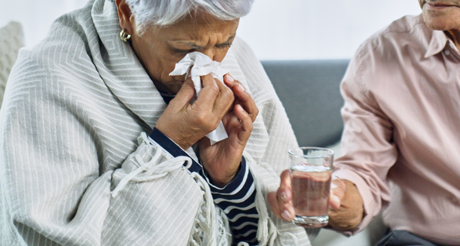- Home
- News and events
- Find news
- Flu drug most beneficial to severely ill and older people
Flu drug most beneficial to severely ill and older people
 Older and severely ill influenza patients recover two or three days earlier, on average, if they are given antiviral flu medication. Other people regain their health one day sooner, on average, with the same treatment. This is clear from a European study implemented over three flu seasons.
Older and severely ill influenza patients recover two or three days earlier, on average, if they are given antiviral flu medication. Other people regain their health one day sooner, on average, with the same treatment. This is clear from a European study implemented over three flu seasons.
“Patients who are older, whose flu is worse and who have other diseases at the same time get most benefit from the treatment.”
The speaker is Pär-Daniel Sundvall, family physician and researcher at Sahlgrenska Academy, University of Gothenburg, and Region Västra Götaland. Sundvall headed the Swedish part of the study.
Fifteen European countries and a total of 3,266 patients with influenza symptoms were involved in the study, which was funded by the European Commission and led from the University of Oxford (UK) and Utrecht University (Netherlands).
Its publication in The Lancet coincides with the start of the flu season in Sweden and the rest of Europe. According to the Public Health Agency of Sweden, its incidence is still low, but it is expected to rise in the next few weeks.
Inhibition and relief
The drug oseltamivir, sold under the brand names Ebilfumin and Tamiflu, belongs to a category of pharmaceuticals that are neither vaccines nor cures for influenza, but inhibit the progression of the disease in the body and relieve its symptoms.
In Sweden, treatment with drugs in this category is recommended for suspected flu in patients who belong to a risk group. Examples of risk groups are people aged 65 and over, individuals with chronic cardiac or pulmonary disease, and those suffering from severe flu.
However, this antiviral treatment is seldom prescribed in primary care, since the drug has been controversial. The reason is the lack of evidence, from independent studies, of its effect in ordinary primary care, and of whether it particularly benefits specific groups of patients.
In the present research, this variation in benefit was the specific aspect studied — on a large scale and with public funding. Over three influenza seasons, patients with flu-like symptoms were recruited. In Sweden, some 70 patients in Southwest Sweden (Västra Götaland and Halland Counties) were involved.
Severely ill gained most
Besides its findings on faster recovery, the study shows that treatment commenced 48–72 hours after onset of illness is as effective as early treatment. Another result is that if one person in a household was treated, other members’ risk of falling ill decreased.
The study confirms previously known side effects of oseltamivir. Nausea and vomiting were more common among those who took the drug. In the researchers’ view, doctors therefore need to weigh up adverse effects against potential advantages in different patient groups.
 “For an otherwise healthy teenager, one day more or less probably doesn’t seem to make that much difference. But if the patient is older, has heart failure and is in a bad way with flu, there’s a gain in this. The study provides good support for treating those patients that the guidelines actually say we should treat,” Pär-Daniel Sundvall says.
“For an otherwise healthy teenager, one day more or less probably doesn’t seem to make that much difference. But if the patient is older, has heart failure and is in a bad way with flu, there’s a gain in this. The study provides good support for treating those patients that the guidelines actually say we should treat,” Pär-Daniel Sundvall says.
Contact: Pär-Daniel Sundvall
Images: Genre image by iStock and head shot of Pär-Daniel Sundvall